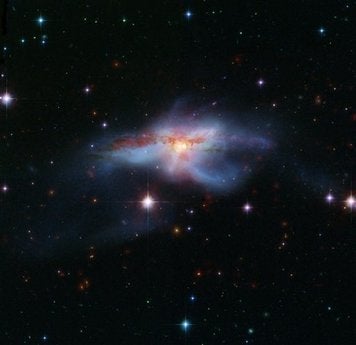
The rain of planets continues. In the past few weeks astronomers have ponied up at least ten times as many planets as were discovered in the previous 200-thousand-year history of our species. Needless to say, all of these planets orbit stars other than the Sun. They are someone else's backyard worlds, not ours.
Despite this storm of discovery, no one has yet found a planet that could be definitely tagged as Earth-like. That's surely just a matter of temporary circumstance, not of permanent fact. NASA's Kepler telescope, which is ladling out new worlds at an average rate of more than one a day, is very likely to find some terrestrial cousins before the next presidential election. You can bet that story will make the front page.
But meanwhile, the planet hunt is changing ideas about what qualifies as desirable celestial real estate.
NASA and the SETI Institute have just announced the discovery of a Saturn-sized planet around a binary star known as Kepler 16. What are binary stars? They're a sub-category of a catch-all group known as double stars. In the eighteenth century, after telescopes finally got beyond the toy stage, astronomers found hundreds (and eventually many thousands) of what looked like stellar pairs, which they ingeniously called "double stars." But were these pairs really "couples" -- dancing around one another -- or merely unrelated stars at different distances that happened to nearly line up in the sky? To separate the true binaries from the chance doubles requires a measurement of the motions of the stars involved, something that became possible only about two centuries ago.
Thanks to a lot of tedious effort, we can now say that roughly 60 percent of all stars are binaries. That's right: our own, lonesome Sun is in the minority. Most stars have buddies.
This has some consequence for our search for life in space. In particular, would it be possible for a planet to form around such a stellar pair and -- more to the point -- hang around for long periods of time? Wouldn't the alternating tugs of two stars quickly disrupt the orbit of any planet, eventually kicking it out into the pitiless darkness of deep space?
The Kepler telescope has shown that such baneful exile is not inevitable. A team led by SETI Institute colleague Laurance Doyle has found a world happily at home in the Kepler 16 system, parading in a wide arc around both stars once every 229 days. The planet is roughly the same distance from its two stellar masters as Venus is from the Sun, and its orbit is nearly circular. However, unlike Venus, this is not a torrid world with temperatures more suitable for smelting soft metals than supporting life. Its host suns are both dwarfish stars, and even their combined light is too weak to raise the temperature on the newly found planet above the freezing point.
Of course, there could be some other worlds in this system, still undiscovered. Doyle notes that "if you stuck an Earth-size planet just inside the orbit of this one, it might be habitable."
But because of the changing aspect of the two suns in its sky, this putative Earth-size world "would experience temperature swings of about 30 degrees every 1-1/2 months." OK, that's a lot of thermometer exercise, but if the planet had a thick atmosphere to smooth out the fluctuations, it might be a tolerable place to live.
But whether or not the Kepler 16 system has biology is not really the point. The substance of this discovery is that the 60 percent of stars that are members of pairs are no longer personae non grata in our search for life.
In other words, you could say that -- in a stroke -- we've more or less doubled the number of places where it's reasonable to think that life might exist. It didn't have to be that way, after all. It might have turned out that possible habitats for biology were rarer than a Bugatti Royale.
Inevitably, Doyle's new planet conjures up images of Luke Skywalker's home world, Tatooine -- the fictional planet that soothed its inhabitants with romantic double sunsets. Doyle admits that everyone is already referring to Kepler 16's world as Tatooine, and he finds the name appealing too. But there's this difference: The Kepler 16 star system is nearly 200 times closer than Tatooine is reputed to be. And this planet is for real.
You can learn more about this discovery here